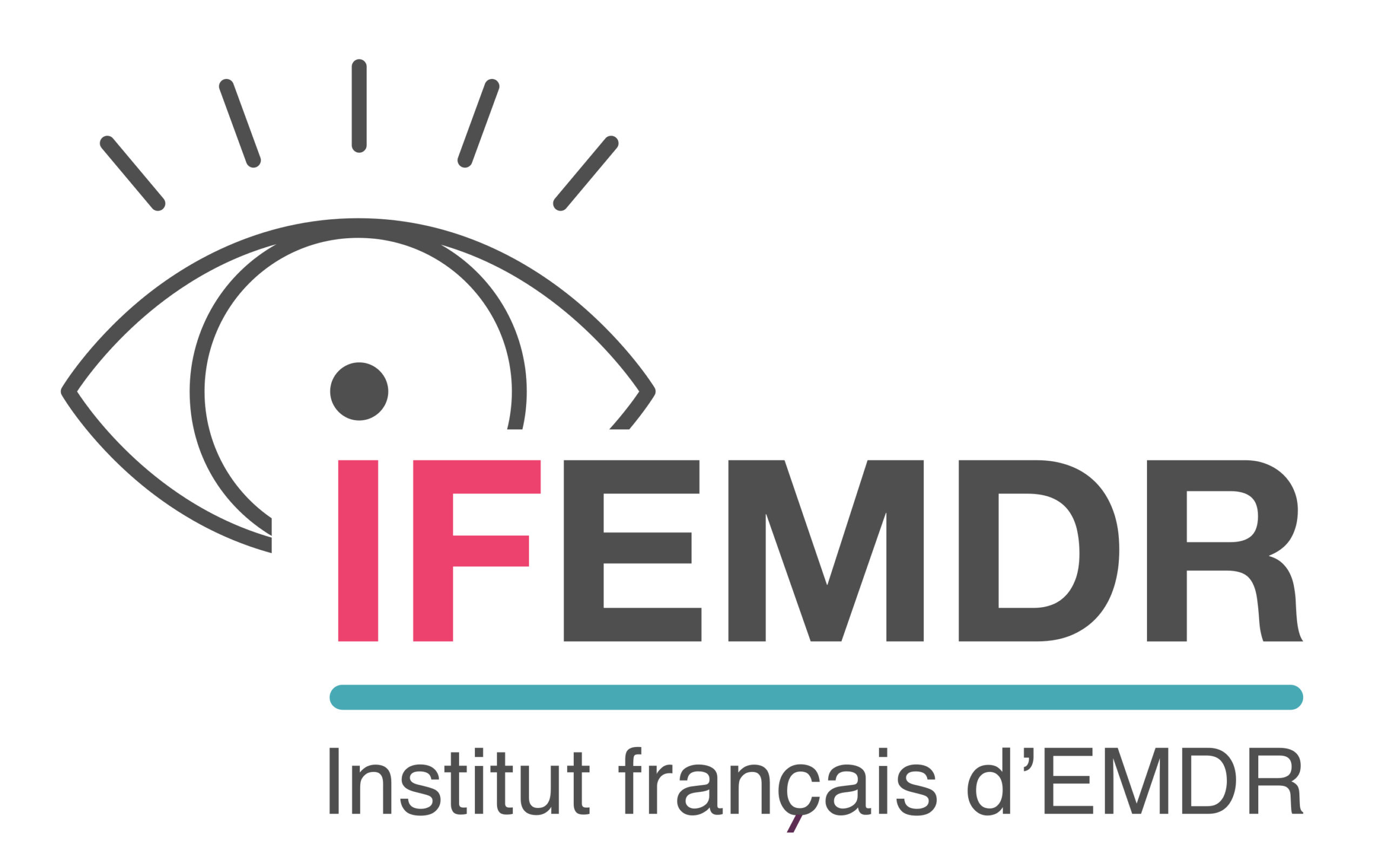
Mécanisme d’action de l’EMDR
Mis à jour le 30 mars 2023
L’EMDR contient de nombreuses procédures et éléments qui contribuent aux effets du traitement. Bien que la méthodologie utilisée dans l’EMDR ait été largement validée (voir ci-dessus), des questions subsistent concernant le mécanisme d’action. Cependant, étant donné que l’EMDR produit des effets cliniques sans avoir besoin de faire ses devoirs, ou de la concentration prolongée utilisée dans les thérapies d’exposition, on a prêté attention aux processus neurobiologiques possibles qui pourraient être évoqués. Bien que les mouvements oculaires (et toute autre stimulation à double attention) constituent un seul élément procédural, cet élément a été soumis à un examen minutieux.
Principales études
Armstrong, N. and Vaughan K. (1994). An orienting response model for EMDR. Paper presented at the meeting of the New South Wales Behavior Therapy Interest Group, Sydney, Australia
Barrowcliff AL; MacCulloch MJ, Gray NS; MacCulloch S, Freeman TCA (2001) The de-arousal model of Eye Movement Desensitization and Reprocessing (EMDR), An investigation of the mechanisms underlying treatment effects in EMDR. Paper presented at the EMDR-Europe Annual Conference, 5. May 2001, London.
Boukezzi, S., Silva, C., Nazarian, B., Rousseau, P. F., Guedj, E., Valenzuela-Moguillansky, C., & Khalfa, S. (2017). Bilateral alternating auditory stimulations facilitate fear extinction and retrieval. Frontiers in Psychology, 8, 990. doi:10.3389/fpsyg.2017.00990
Brennstuhl, M.-J., Bassan, F., & Tarquinio, C. (2019). Analysis and comparison of speech of chronic pain patients during therapy as usual versus use of an Eye Movement Desensitization and Reprocessing (EMDR) therapy. [Analyse et comparaison de discours de patients douloureux chroniques durant une thérapie de soutien par opposition à l’utilisation de la thérapie Eye Movement Desensitization and Reprocessing (EMDR).] Pratiques Psychologiques, 25(4), 441-451. doi:10.1016/j.prps.2018.06.003
Calancie, O. G., Khalid-Khan, S., Booij, L., & Munoz, D. P. (2018). Eye movement desensitization and reprocessing as a treatment for PTSD: current neurobiological theories and a new hypothesis. Ann N Y Acad Sci.
Carletto, S., Borsato, T., & Pagani, M. (2017). The Role of Slow Wave Sleep in Memory Pathophysiology: Focus on Post-traumatic Stress Disorder and Eye Movement Desensitization and Reprocessing. Front Psychol, 8, 2050.
Chamberlin, D. E. (2019). The Predictive Processing Model of EMDR. Front Psychol, 10, 2267. https://doi.org/10.3389/fpsyg.2019.02267
Chamberlin, D. E. (2019). The Network Balance Model of Trauma and Resolution—Level I: Large-Scale Neural Networks. Journal of EMDR Practice and Research, 13(2), 124-142. doi:10.1891/1933-3196.13.2.124
Cooper, R. Z., Smith, A. D., Lewis, D., Lee, C. W., & Leeds, A. M. (2019). Developing the Interrater Reliability of the Modified EMDR Fidelity Checklist. Journal of EMDR Practice and Research, 13(1), 32-50. doi:10.1891/1933-3196.13.1.32
De Jongh, A., Ernst, R., Marques, L., & Hornsveld, H. (2013). The impact of eye movements and tones on disturbing memories of patients with PTSD and other mental disorders. Journal of Behavior Therapy and Experimental Psychiatry, 44, 447–483.
- The findings provide further evidence for the value of employing eye movements in EMDR treatments. The results also support the notion that EMDR is a suitable option for resolving disturbing memories underlying a broader range of mental health problems than PTSD alone.
El Haj, M., Nandrino, J. L., Antoine, P., Boucart, M., & Lenoble, Q. (2017). Eye movement during retrieval of emotional autobiographical memories. Acta Psychologica, 174, 54-58. doi:10.1016/j.actpsy.2017.02.002
El Khoury-Malhame, M. et al. (2011). Attentional bias in post-traumatic stress disorder diminishes after symptom amelioration. Behaviour Research and Therapy 49, 796-801.
- English abstract : Attentional bias toward aversive cues in PTSD has been hypothesized as being part of the dysfunction causing etiology and maintenance of PTSD. The aim of the present study was to investigate the cognitive strategy underlying attentional bias in PTSD and whether normal cognitive processing is restored after a treatment suppressing core PTSD symptoms.” An average of 4.1 EMDR sessions resulted in remission of PTSD. Post treatment “similarly to controls, EMDR treated patients who were symptom free had null e-Stroop and disengagement indices.
Elofsson, U.O.E., von Scheele, B., Theorell, T., & Sondergaard, H.P. (2008). Physiological correlates of eye movement desensitization and reprocessing. Journal of Anxiety Disorders, 22(4), 622-634.
- English abstract : Changes in heart rate, skin conductance and LF/HF-ratio, finger temperature, breathing frequency, carbon dioxide and oxygen levels were documented during the eye movement condition. It was concluded the “eye movements during EMDR activate cholinergic and inhibit sympathetic systems. The reactivity has similarities with the pattern during REM sleep.”
- Abstract en français : Des changements au niveau du rythme cardiaque, de la conduction de la peau et du ratio basses fréquences/hautes fréquences, la température des doigts, la fréquence respiratoire, les niveaux de dioxide de carbone et d’oxygène ont été documentés pendant les mouvements oculaires. Les conclusions montrent que les mouvements oculaires pendant l’EMDR activent les systèmes cholinergiques et inhibent les systèmes sympathiques. Cette réactivité présente des similarités avec les patterns observés pendant le sommeil REM.
Harricharan, S., McKinnon, M. C., Tursich, M., Densmore, M., Frewen, P., Théberge, J., . . . Lanius, R. A. (2019). Overlapping frontoparietal networks in response to oculomotion and traumatic autobiographical memory retrieval: implications for eye movement desensitization and reprocessing. European Journal of Psychotraumatology, 10(1), 1586265. doi:10.1080/20008198.2019.1586265
Hornsveld, H. K., Landwehr, F., Stein, W., Stomp, M., Smeets, S., & van den Hout, M. A. (2010). Emotionality of loss-related memories is reduced after recall plus eye movements but not after recall plus music or recall only. Journal of EMDR Practice and Research, 4, 106-112.
- English abstract : Recall-plus-music was added to investigate whether reductions in emotionality are associated with relaxation. . . Participants reported a greater decline in emotionality and concentration after eye movements in comparison to recall-only and recall-with-music. It is concluded that eye movements are effective when negative memories pertain to loss and grief.
Kapoula Z, Yang Q, Bonnet A, Bourtoire P, Sandretto J (2010). EMDR Effects on Pursuit Eye Movements. PLoS ONE 5(5): e10762. doi:10.1371/journal.pone.0010762
- English abstract : EMDR treatment of autobiographic worries causing moderate distress resulted in an “increase in the smoothness of pursuit [which] presumably reflects an improvement in the use of visual attention needed to follow the target accurately. Perhaps EMDR reduces distress thereby activating a cholinergic effect known to improve ocular pursuit.
Kristjánsdóttir, K. & Lee, C. M. (2011). A comparison of visual versus auditory concurrent tasks on reducing the distress and vividness of aversive autobiographical memories. Journal of EMDR Practice and Research, 5, 34-41.
- English abstract : Results showed that vividness and emotionality ratings of the memory decreased significantly after eye movement and counting, and that eye movement produced the greatest benefit. Furthermore, eye movement facilitated greater decrease in vividness irrespective of the modality of the memory. Although this is not consistent with the hypothesis from a working memory model of mode-specific effects, it is consistent with a central executive explanation.
Lee, C.W., Taylor, G., & Drummond, P.D. (2006) The active ingredient in EMDR: Is it traditional exposure or dual focus of attention? Clinical Psychology and Psychotherapy, 13, 97-107.
- English abstract : This study tested whether the content of participants’ responses during EMDR is similar to that thought to be effective for traditional exposure treatments (reliving), or is more consistent with distancing which would be expected given Shapiro’s proposal of dual focus of attention. Greatest improvement on a measure of PTSD symptoms occurred when the participant processed the trauma in a more detached manner.
- Abstract en français : Cette étude a testé si le contenu des réponses des participants pendant la thérapie EMDR était similaire à ce qui est considéré comme efficace pour les traitement d’exposition traditionnels ou s’il est davantage cohérent avec la distanciation attendue d’après la proposition de Francine SHAPIRO sur l’attention double. L’amélioration la plus importante au niveau des symptômes d’ESPT a eu lieu quand le participant traitait le trauma d’une manière plus détachée.
Leeds, A. M., & Korn, D. L. (2012). A commentary on Hornsveld et al. (2011): A valid test of resource development and installation? Absolutely not. Journal of EMDR Practice and Research, 6(4), 170-173. doi:10.1891/1933-3196.6.4.170
Leer, A., Engelhard, I. M., & van den Hout, M. A. (2014). How eye movements in EMDR work: changes in memory vividness and emotionality. Journal of behavior therapy and experimental psychiatry, 45 (3), 396-401.
- English abstract : This study provides corroborating evidence that EM during recall causes reductions in memory vividness and emotionality at a delayed post-test and that the magnitude of these effects is related to intervention duration.
Leer, A., Engelhard, I. M., Lenaert, B., Struyf, D., Vervliet, B., & Hermans, D. (2017). Eye movement during recall reduces objective memory performance: An extended replication. Behaviour Research and Therapy, 92, 94-105. doi:10.1016/j.brat.2017.03.002
Lilley, S.A. , Andrade, J., Graham Turpin, G.,Sabin-Farrell, R. & Emily A. Holmes, E.A. (2009). Visuospatial working memory interference with recollections of trauma. British Journal of Clinical Psychology, 48, 309–321.
- English abstract : Tested patients awaiting PTSD treatment and demonstrated that the eye movement condition had a significant effect on vividness of trauma memory and emotionality compared to counting and exposure only. In addition, “the counting task had no effect on vividness compared to exposure only, suggesting that the eye-movement task had a specific effect rather than serving as a general distractor” (p. 317)
Littel, M., van Schie, K., & van den Hout, M. A. (2017). Exploring expectation effects in EMDR: Does prior treatment knowledge affect the degrading effects of eye movements on memories? European Journal of Psychotraumatology, 8(sup1), 1328954. Présentation en français : Les suggestions verbales sur l’efficacité du traitement ne modulent pas l’efficacité d’un modèle de laboratoire de thérapie EMDR :
Lipke, H. (1992). Manual for the teaching of Shapiro’s EMDR in the treatment of combat related PTSD EMDR Institute
MacCulloch, M. J., & Feldman, P. (1996). Eye movement desensitization treatment utilizes the positive visceral element of the investigatory reflex to inhibit the memories of post-traumatic stress disorder: A theoretical analysis. British Journal of Psychiatry, 169(5), 571–579.
- English abstract : One of a variety of articles positing an orienting response as a contributing element (see Shapiro, 2001 for comprehensive examination of theories and suggested research parameters). This theory has received controlled research support (Barrowcliff et al., 2003, 2004).
- Abstract en français : Un des articles qui postulent qu’une réaction d’orientation intervient (cf. Shapiro 2001, pour une revue globale des théories et pour des suggestions de paramètres à étudier). Cette théorie a été corroborée par certaines études contrôlées (Barrowcliff et al., 2003, 2004).
Matthijssen, S. J. M. A., Brouwers, T., van Roozendaal, C., Vuister, T., & de Jongh, A. (2021). The effect of EMDR versus EMDR 2.0 on emotionality and vividness of aversive memories in a non-clinical sample. Eur J Psychotraumatol, 12(1), 1956793. doi:10.1080/20008198.2021.1956793
Mertens, G., Bouwman, V., Asmervik, J. F., & Engelhard, I. M. (2019). Changing emotional visual and auditory memories: are modality-matched dual-tasks more effective. Cogn Emot, 1-14. doi:10.1080/02699931.2019.1666800. Présentation en français : Changer les souvenirs émotionnels visuels et auditifs : les doubles tâches assorties de modalités sont-elles plus efficaces ?
Mertens, G., van Schie, K., Lammertink, S., Littel, M., & Engelhard, I. (2020). Verbal suggestions about treatment effectiveness do not modulate the effectiveness of a laboratory model of EMDR therapy: Results of two preregistered studies. doi:10.31234/osf.io/zhcpn Présentation en français : Les suggestions verbales sur l’efficacité du traitement ne modulent pas l’efficacité d’un modèle de laboratoire de thérapie EMDR
Moore, T., Phillips, J. S., Erskine, S. E., & Nunney, I. (2020). What Has EMDR Taught Us About the Psychological Characteristics of Tinnitus Patients. Journal of EMDR Practice and Research, 14(4), 229-240. doi:10.1891/emdr-d-19-00055 Présentation en français : Qu’est-ce que l’EMDR nous a appris sur les caractéristiques psychologiques des patients souffrant d’acouphènes?
Nicosia, G. J. (1994). The QEEG of PTSD with EMDR. Paper presented at the International EMDR-Conference, Sunnyvale, California.
Stickgold, R. (2002). EMDR : A putative Mechanism of Action. Journal of Clinical Psychology (58), 61-76
Nieuwenhuis, S., Elzinga, B. M., Ras, P. H., Berends, F., Duijs, P., Samara, Z., & Slagter, H. A. (2012). Bilateral saccadic eye movements and tactile stimulation, but not auditory stimulation, enhance memory retrieval. Brain and Cognition, 81(1), 52-56. doi:10.1016/j.bandc.2012.10.003
Pagani, M., & Carletto, S. (2017). A hypothetical mechanism of action of EMDR: The role of slow wave sleep. Clinical Neuropsychiatry, 14(5), 301-305.
Pagani, M., Amann, B. L., Landin-Romero, R., & Carletto, S. (2017). Eye Movement Desensitization and Reprocessing and Slow Wave Sleep: A Putative Mechanism of Action. Front Psychol, 8, 1935.
Propper, R., Pierce, J.P., Geisler, M.W., Christman, S.D., & Bellorado, N. (2007). Effect of bilateral eye movements on frontal interhemispheric gamma EEG coherence: Implications for EMDR therapy. Journal of Nervous and Mental Disease, 195(9), 785-788.
- English abstract : Specifically, the EM manipulation used in the present study, reported previously to facilitate episodic memory, resulted in decreased interhemispheric EEG coherence in anterior prefrontal cortex. Because the gamma band includes the 40 Hz wave that may indicate the active binding of information during the consolidation of long-term memory storage (e.g., Cahn and Polich, 2006), it is particularly notable that the changes in coherence we found are in this band. With regard to PTSD symptoms, it may be that by changing interhemispheric coherence in frontal areas, the EMs used in EMDR foster consolidation of traumatic memories, thereby decreasing the memory intrusions found in this disorder.
- Abstract en français : Spécifiquement, la manipulation Mouvements Oculaires utilisée dans la présente étude, rapportée précédemment comme facilitant la mémoire épisodique, a provoqué une diminution de la cohérence EEG interhémisphérique dans le cortex préfrontal antérieur. Puisque la bande gamma inclut la fréquence 40 Hz qui pourrait indiquer l’ancrage actif de l’information pendant la consolidation du stockage de la mémoire à long terme (par ex. Cahn et Polich, 2006), il est à noter particulièrement que les changements dans la cohérence que nous avons trouvés se trouvent dans cette bande. Au regard des symptômes ESPT, il se peut qu’en modifiant la cohérence interhémisphérique dans les aires frontales, les mouvements oculaires utilisés en EMDR engendrent la consolidation des souvenirs traumatiques, diminuant par là même les souvenirs intrusifs observés dans ce trouble.
Rogers, S., Silver, S., Goss, J., Obenchain, J., Willis, A., & Whitney, R. (1999). A single session, controlled group study of flooding and eye movement desensitization and reprocessing in treating posttraumatic stress disorder among Vietnam war vétérans : Preliminary data. Journal of Anxiety Disorders, 13, 119–130.
- English abstract : This study was designed as primarily a process report to compare EMDR and exposure. A different recovery pattern was observed with the EMDR group demonstrating a more rapid decline in self-reported distress.
- Abstract en français : Cette étude a été conçue pour comparer la thérapie EMDR et l’exposition. Une style de guérison différent, observé depuis le groupe EMDR, montre une diminution plus rapide de la détresse rapportée chez les sujets.
Rogers, S., & Silver, S. M. (2002). Is EMDR an exposure therapy ? A review of trauma protocols. Journal of Clinical Psychology, 58, 43-59.
- English abstract : Theoretical, clinical, and procedural differences referencing two decades of CBT and EMDR research.
- Abstract en français : Comparaison détaillée de la théorie, des pratiques et des procédures de la thérapie EMDR et des thérapies par exposition.
Rousseau, P. F., Boukezzi, S., Garcia, R., Chaminade, T., & Khalfa, S. (2020). Cracking the EMDR code: Recruitment of sensory, memory and emotional networks during bilateral alternating auditory stimulation. Aust N Z J Psychiatry, 4867420913623. doi:10.1177/0004867420913623 – Présentation en français : Déchiffrer le code EMDR : Recrutement de réseaux sensoriels, mémoriels et émotionnels lors d’une stimulation auditive bilatérale alternée
Sack, M., Hofmann, A., Wizelman, L., & Lempa, W. (2008). Psychophysiological changes during EMDR and treatment outcome. Journal of EMDR Practice and Research, 2, 239-246
- English abstract : During-session changes in autonomic tone were investigated in 10 patients suffering from single-trauma PTSD. Results indicate that information processing during EMDR is followed by during-session decrease in psychophysiological activity, reduced subjective disturbance and reduced stress reactivity to traumatic memory.
Sack, M., Lempa, W. Steinmetz, A., Lamprecht, & Hofmann, A. (2008). Alterations in autonomic tone during trauma exposure using eye movement desensitization and reprocessing (EMDR) – results of a preliminary investigation. Journal of Anxiety Disorders.
- English abstract : The psycho-physiological correlates of EMDR were investigated during treatment sessions. The initiation of the eye movements sets resulted in immediate changes that indicated a pronounced de-arousal.
- Abstract en français : Sack et al., (université de Munich, en Allemagne) montrent que dans la phase initiale des MO (première 10 secondes), on constate une augmentation du tonus parasympathique qui ralentit légèrement le rythme cardiaque, tout en augmentant la variabilité cardiaque (comme dans la cohérence cardiaque). Cette phase, au cours de laquelle il y a nécessairement une augmentation de la libération d’acetylcholine (le neurotransmetteur du système parasympathique) pourrait être associée à une facilitation des associations dans le réseau mnésique, comme on le voit pendant le sommeil paradoxal associé à l’activité onirique. Par la suite (de 10 à 90 secondes après le début de la stimulation par le MO), il y a, au contraire, une augmentation du rythme cardiaque probablement associée à une libération de noradrénaline (système nerveux sympathique) qui correspondrait à l’activation et la peur associées à l’exposition au souvenir traumatique et qu’on observe classiquement dans les thérapies d’exposition.
Servan-Schreiber, D., Schooler, J., Dew, M.A., Carter, C., & Bartone, P. (2006). EMDR for PTSD : A pilot blinded, randomized study of stimulation type. Psychotherapy and Psychosomatics, 75, 290-297.
- English abstract : Twenty-one patients with single-event PTSD (average IES: 49.5) received three consecutive sessions of EMDR with three different types of auditory and kinesthetic stimulation. All were clinically useful. However, alternating stimulation conferred an additional benefit to the EMDR procedure.
- Abstract en français : 21 patients avec un ESPT avec trauma unique (moyenne IES : 49,5) ont reçu 3 séances consécutives d’EMDR avec 3 types différents de stimulation auditive et kinés thésique
Servan-Schreiber, D. (2000). Eye-Movement Desensitization and Reprocessing: Is Psychiatry missing the point? Psychiatric Times 17(7): 36-40.
Servan-Schreiber, D. (2002). Eye-Movement Desensitization and Reprocessing Psychotherapy : A model for integrative medicine. Alternative Therapies in Health and Medicine 8: 100-103.
Stickgold, R. (2002). EMDR: A putative neurobiological mechanism of action. Journal of Clinical Psychology, 58(1), 61-75.
- English abstract : Comprehensive explanation of the potential links to the processes that occur in REM sleep. Controlled studies have evaluated these theories (see below ; Christman et al., 2004 ; Kuiken et al. 2001-2002
- Abstract en français : Exposé des éléments de neurobiologie et des systèmes mnésiques impliqués dans le sommeil paradoxal et de leur lien possible avec le mode d’action de la thérapie EMDR.
Stickgold, R. (2008). Sleep-dependent memory processing and EMDR action. Journal of EMDR Practice and Research, 2(4), 289-299.
- English abstract : Comprehensive explanations of mechanisms and the potential links to the processes that occur in REM sleep. Controlled studies have evaluated these theories (see next section; Christman et al., 2003; Kuiken et al. 2001-2002).
Suzuki A, Josselyn SA, Frankland PW, Masushige S, Silva AJ, Kida S. (2004). Memory reconsolidation and extinction have distinct temporal and biochemical signatures. Journal of Neuroscience, 24, 4787– 4795.
- English abstract : The article explores the differences between memory reconsolidation and extinction. This new area of investigation is worthy of additional attention. Reconsolidation may prove to be the underlying mechanism of EMDR, as opposed to extinction caused by prolonged exposure therapies. « Memory reconsolidation after retrieval may be used to update or integrate new information into long-term memories…Brief exposure… seems to trigger a second wave of memory consolidation (reconsolidation), whereas prolonged exposure… leads to the formation of a new memory that competes with the original memory (extinction). »
- Abstract en français : L’article explore les différences entre la reconsolidation de la mémoire et son extinction. Ce nouveau domaine d’investigation mérite une attention supplémentaire. La reconsolidation pourrait se révéler comme étant le méchanisme sous-jacent de l’EMDR, plutôt que l’extinction provoquée par les thérapies d’exposition prolongée. «La reconolidation de la mémoire après sa récupération peut servir à mettre à jour ou à intégrer des nouvelles informations au niveau de la mémoire à long terme… L’exposition brève… semble entraîner une deuxième vague de consolidation de la mémoire (reconsolidation) tandis que l’exposition prolongée… engendrerait la formation d’un nouveau souvenir qui est en compétition avec le souvenir originel (extinction).»
Thomaes, K., Engelhard, I. M., Sijbrandij, M., Cath, D. C., & Heuvel, O. A. V. D. (2016). Degrading traumatic memories with eye movements: A pilot functional MRI study in PTSD. European Journal of Psychotraumatology, 7(0). doi:10.3402/ejpt.v%v.31371
Van den Hout, M. A., Rijkeboer, M. M., Engelhard, I. M., Klugkist, I., Hornsveld, H., Toffolo, M. J., & Cath, D. C. (2012). Tones inferior to eye movements in the EMDR treatment of PTSD. Behaviour Research and Therapy, 50(5), 275-279. doi:10.1016/j.brat.2012.02.001
- English abstract : EMs outperformed tones while it remained unclear if tones add to recall only. . . EMs were superior to tones in reducing the emotionality and vividness of trauma memories. [I]n contrast to EMs, tones hardly tax working memory and induce a smaller reduction in emotionality and vividness of aversive memories. Interestingly, patients’ preferences did not follow this pattern: the perceived effectiveness was higher for tones than for EMs. . . . Clearly, the superior effects of EMs on emotionality and vividness of trauma memories were not due to demand characteristics.
Van den Hout, M., & Engelhard, I. (2012). How does EMDR work? Journal of Experimental Psychopathology, 3, 724-738.
Vanderschoot, T., & Dessel, P. V. (2022). EMDR Therapy and PTSD: A Goal-Directed Predictive Processing Perspective. Journal of EMDR Practice and Research, EMDR-2022. https://doi.org/10.1891/emdr-2022-0009
Van Schie, K., van Veen, S. C., Engelhard, I. M., Klugkist, I., & van den Hout, M. A. (2016). Blurring emotional memories using eye movements: Individual differences and speed of eye movements. European Journal of Psychotraumatology, 7.
- English abstract : Contrary to the theory, the data do not support the hypothesis that EM speed should be adjusted to [working memory capacity] (hypothesis 4). However, the data show that a dual task in general is more effective in reducing memory ratings than no dual task (hypothesis 1), and that a more cognitively demanding dual task increases the intervention’s effectiveness (hypothesis 2).
- Résumé en français : Contrairement à la théorie, les données ne soutiennent pas l’hypothèse selon laquelle la vitesse des MO devrait être ajustée à [la capacité de la mémoire de travail] (hypothèse 4). Cependant, les données montrent qu’une attention double en général est plus efficace pour réduire les évaluations de la mémoire que l’absence d’attention double (hypothèse 1), et qu’une attentiuon double plus exigeante sur le plan cognitif augmente l’efficacité de l’intervention (hypothèse 2).
- Présentation de cette recherche en français : Capacité de mémoire de travail et vitesse des MO
Wadji, D. L., Martin-Soelch, C., & Camos, V. (2022). Can working memory account for EMDR efficacy in PTSD. BMC Psychol, 10(1), 245. https://doi.org/10.1186/s40359-022-00951-0
Wilson, D., Silver, S. M., Covi, W., & Foster, S. (1996). Eye movement desensitization and reprocessing: Effectiveness and autonomic correlates. Journal of Behaviour Therapy and Experimental Psychiatry, 27(3), 219–229.
- English abstract : Study involving biofeedback equipment has supported the hypothesis that the parasympathetic system is activated by finding that eye movements appeared to cause a compelled relaxation response. More rigorous research with trauma populations is needed.
- Résumé en français : Une étude impliquant le biofeedback soutient l’hypothèse que le système parasympathique est activé en montrant que les mouvements oculaires semblent provoquer une réponse de relaxation. Plus de recherches rigoureuses avec des populations atteintes de traumas sont nécessaires.
Wong, S.-L. (2021). A Model for the Flash Technique Based on Working Memory and Neuroscience Research. Journal of EMDR Practice and Research, 15(3), 174-184. doi:10.1891/emdr-d-21-00048
Wynn, J. S., Ryan, J. D., & Buchsbaum, B. R. (2020). Eye movements support behavioral pattern completion. Proc Natl Acad Sci U S A, 117(11), 6246-6254. doi:10.1073/pnas.1917586117
En savoir plus :



